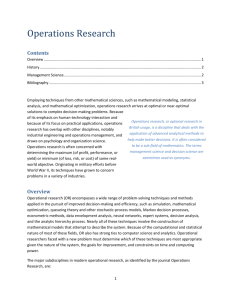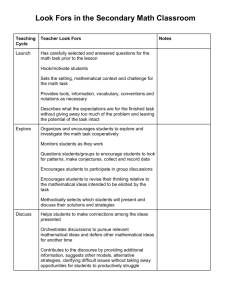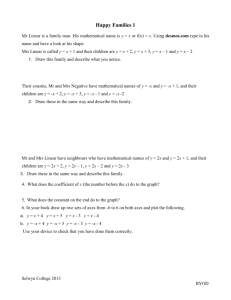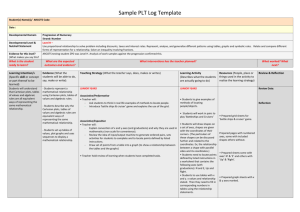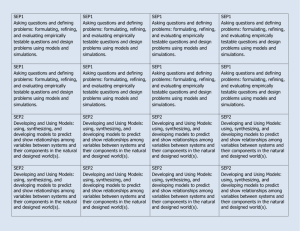docx - Teach Engineering
advertisement
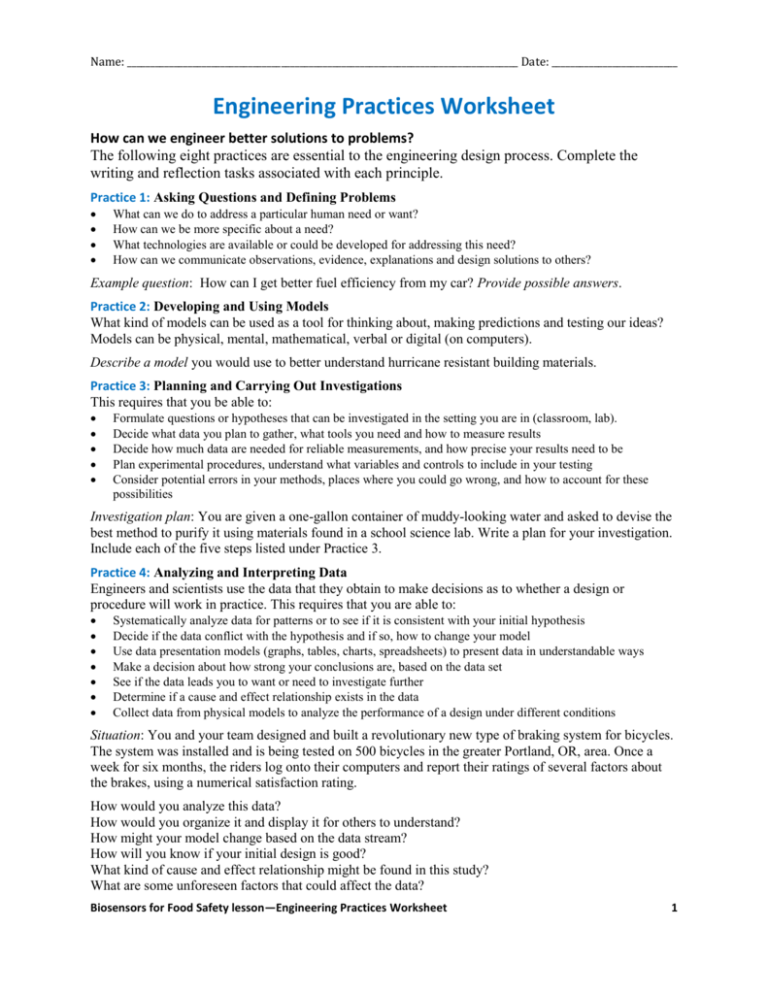
Name: ____________________________________________________________________________________ Date: ___________________________ Engineering Practices Worksheet How can we engineer better solutions to problems? The following eight practices are essential to the engineering design process. Complete the writing and reflection tasks associated with each principle. Practice 1: Asking Questions and Defining Problems What can we do to address a particular human need or want? How can we be more specific about a need? What technologies are available or could be developed for addressing this need? How can we communicate observations, evidence, explanations and design solutions to others? Example question: How can I get better fuel efficiency from my car? Provide possible answers. Practice 2: Developing and Using Models What kind of models can be used as a tool for thinking about, making predictions and testing our ideas? Models can be physical, mental, mathematical, verbal or digital (on computers). Describe a model you would use to better understand hurricane resistant building materials. Practice 3: Planning and Carrying Out Investigations This requires that you be able to: Formulate questions or hypotheses that can be investigated in the setting you are in (classroom, lab). Decide what data you plan to gather, what tools you need and how to measure results Decide how much data are needed for reliable measurements, and how precise your results need to be Plan experimental procedures, understand what variables and controls to include in your testing Consider potential errors in your methods, places where you could go wrong, and how to account for these possibilities Investigation plan: You are given a one-gallon container of muddy-looking water and asked to devise the best method to purify it using materials found in a school science lab. Write a plan for your investigation. Include each of the five steps listed under Practice 3. Practice 4: Analyzing and Interpreting Data Engineers and scientists use the data that they obtain to make decisions as to whether a design or procedure will work in practice. This requires that you are able to: Systematically analyze data for patterns or to see if it is consistent with your initial hypothesis Decide if the data conflict with the hypothesis and if so, how to change your model Use data presentation models (graphs, tables, charts, spreadsheets) to present data in understandable ways Make a decision about how strong your conclusions are, based on the data set See if the data leads you to want or need to investigate further Determine if a cause and effect relationship exists in the data Collect data from physical models to analyze the performance of a design under different conditions Situation: You and your team designed and built a revolutionary new type of braking system for bicycles. The system was installed and is being tested on 500 bicycles in the greater Portland, OR, area. Once a week for six months, the riders log onto their computers and report their ratings of several factors about the brakes, using a numerical satisfaction rating. How would you analyze this data? How would you organize it and display it for others to understand? How might your model change based on the data stream? How will you know if your initial design is good? What kind of cause and effect relationship might be found in this study? What are some unforeseen factors that could affect the data? Biosensors for Food Safety lesson—Engineering Practices Worksheet 1 Practice 5: Using Mathematics, Information & Computer Technology, and Computational Thinking Math and computation are critical parts of the engineering process. Mathematical models are used to predict all kinds of phenomena that cannot as yet be physically tested, such as quantum physics and atomic structure. Engineers use mathematical models to design bridges and create rare isotopes. As you learn more advanced math concepts, you will be able to: Use the correct mathematical measurements and units for your projects Explain ideas using mathematical forms Understand how computer models are built around complex mathematical processes Test your work using mathematical and computer models to see if they make sense Complete mathematical analyses appropriate to the level of math that you have studied Practice 6: Constructing Explanations and Designing Solutions After you have completed your experiment or tested your design, you should be able to explain how your results fit in with scientific principles or models. This includes: Solving problems by applying your previous scientific knowledge Undertaking design projects, completing all steps of the design process and producing a plan with specific design criteria Constructing a device or implementing a process Evaluating and critiquing the design based on agreed upon criteria Situation: Your team has been assigned the task of designing a pencil sharpener that can sharpen a range of different-sized pencils and have an effective sharpening blade life of five years. What areas of scientific knowledge would be helpful have an understanding of before beginning the design process for this device? Then what additional criteria would be necessary for evaluating and critiquing the design, beyond the two criteria mentioned. Practice 7: Engaging in Argument from Evidence To make a case for an invention requires solid reasoning and logical argumentation in order to convince others that your designs are valuable. This requires that you be able to: Construct a scientific argument showing how your data supports your claims Identify flaws in your argument, then address and improve them Know the difference between claims, data and reasoning Explain why a particular idea may have controversy associated with it Understand how the scientific community judges claims to knowledge Read about other work in the scientific community and judge their strengths and weaknesses Task: Two leading scientists have come up with opposing theories about the expansion of the universe. On what basis would you evaluate their claims? Practice 8: Obtaining, Evaluating and Communicating Evidence To be able to evaluate your work and that of others it is necessary to be highly literate in science and engineering. This requires that you be able to: Use words, tables, diagrams and graphs, as well as mathematical expressions, to communicate your understanding of a topic and ask questions about it Read scientific journals, books and other resources and summarize their arguments Write and speak in a manner that is scientifically oriented Read scientific information with an informed and critical perspective Explain: You read an article in the local newspaper about a proposed new oil pipeline that will pass through your town. You also read an article in a scientific journal about the same topic. Will these articles be written for the same audience and with the same purpose? Probably not! How will these two articles be different? What are some ideas that you would expect to see in one but not the other? Biosensors for Food Safety lesson—Engineering Practices Worksheet 2




